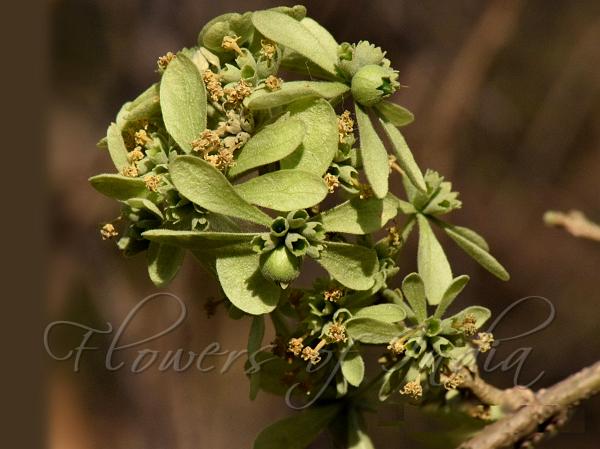|
| Panicled Varshiki |
|

|

| File size | 691319 |
| Original date | 4/5/16 3:48 PM |
| Resolution | 0 x 0 |
| Flash | Flash did not fire |
| Focal length | 300.0mm |
| Exposure time | 1/1600s |
| Aperture | 22.0 |
| Focus Distance | |
| Metering Mode | Multi-segment |
| Camera make | NIKON CORPORATION |
| Camera model | NIKON D3300 |
| Sensor type | OneChipColorArea |
|
|
|
|
Photo: |
Botanical name: Sphenodesme involucrata var. paniculata Family: Lamiaceae (Mint family)
Synonyms: Sphenodesme paniculata
Synonyms: Sphenodesme paniculata
Panicled Varshiki is a large climbing shrub or
woody climber. Branches and branchlets nearly round or bluntly
quadrangular, young parts rusty woolly or velvet-hairy, hairless when
mature. Leaves are simple, opposite, elliptic or ovate, 7-18 × 4-8 cm,
base rounded or blunt, margin entire or very faintly sawtoothed, tip
blunt, leathery, papery, dark green, hairless above and velvet-hairy
beneath, lateral veins 4-6 on either side of the midrib. Leaf-stalk is
slender, hairless, channelled, about 0.8-1.5 cm long. Flowers are borne
at branch-ends in panicles composed of 6-12 opposite dichotomously
branched cymes, about 15-30 x 5-15 cm across, flower-cluster-stalk,
slender, bluntly quadrangular, about 3-6 cm long, involucral bracts 6,
leaflike or leaf-like, spoon-shaped, notched in fruit, membranous and
veined. Flowers are bisexual, fragrant, many, cream colored stalkless
in involucrate heads. Calyx is cup-shaped or nearly bell-shaped, 5
toothed, teeth ovate, pointed, densely star-shaped-woolly, about 6 mm
long, flower funnel-shaped, 5-6 lobed, white, woolly, obovate to
oblong, tip blunt, lower lip 3 lobed, lobes nearly equal, obovate, tip
blunt, flower tube narrow, about 2 x 1.3 mm across, densely
velvet-hairy at throat, hairless outside. Stamens are 5-6, included,
filaments thread-like, hairless, anthers spherical. Fruit is carcerulus
(A type that breaks up on maturity into one-seeded segments or
nutlets), obovoid, hairless, enclosed by persistant sepals, 12 seeded.
Panicled Varshiki is endemic to Western Ghats.
Medicinal uses: Roots are believed to be
vermifuge, antibacterial in local medicine. It is used in the form of
powder or decoction for stomach disorders, ear diseases, worms and
burns.
Roots are believed to be
vermifuge, antibacterial in local medicine. It is used in the form of
powder or decoction for stomach disorders, ear diseases, worms and
burns.
Medicinal uses:
 Roots are believed to be
vermifuge, antibacterial in local medicine. It is used in the form of
powder or decoction for stomach disorders, ear diseases, worms and
burns.
Roots are believed to be
vermifuge, antibacterial in local medicine. It is used in the form of
powder or decoction for stomach disorders, ear diseases, worms and
burns. | Identification credit: S. Kasim | Photographed in Tamil Nadu. |
• Is this flower misidentified? If yes,